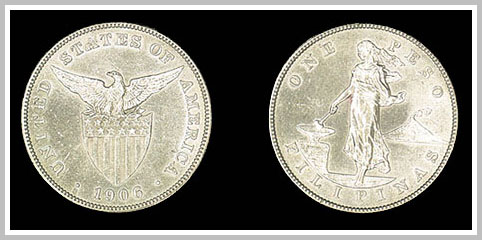| The Coinage
Act of 1903 established in the Philippines a monetary system based on the
gold standard providing for a Philippine Peso pegged to the U.S. Dollar
at 2:1. The series of coins that resulted from this decision is often referred
to as "CONANT COINS" after Charles A. Conant, an American monetary expert.
Philippine pesos were minted in San Francisco and Philadelphia and, from
1903 to 1906, were 416 grams in weight and .900 fine silver.
The designer
and engraver of these coins was Melecio Figueroa, a famous Filipino artist.
The reverse shows a standing female figure in a Philippine
dress with wind-blown hair, clutching a hammer resting on an anvil with
the famous Mayon Volcano at the right background, while the obverse displays
the heraldic American eagle facing left with outspread wings on a stylized
shield version of the American flag.
Not long after
the issuance of the Conant coins, silver prices started to rise, the bullion
market became frantic and silver coins were being smuggled out of the country
in massive quantities. To stem this monetary blood-letting, the American
authorities discontinued the minting of the peso by early 1906 and decided
to recall these coins in order to re-coin them into reduced sizes (308.64
grains) and lesser fineness (.750 fine). As a result of this recall and
re-coining, very few of the original 201,000 1906-S Pesos probably managed
to survive the melting pot as they are now RARER than the SCARCE 1904 (P)
Peso which originally had a lower mintage of only 11,355. The 1906-S Peso
is thus the RAREST and, particularly in high grade, the most sought after
among the U.S.-Philippine coins.
The 1906-S
Peso featured here in ALMOST UNCIRCULATED state (Uncirculated
pieces have been reported but not verified) is the most popular and desirable
of the series and is considered the SIGNATURE COIN of the entire U.S. -
Philippine coinage. Surviving number unknown. (Philippine collection) |


